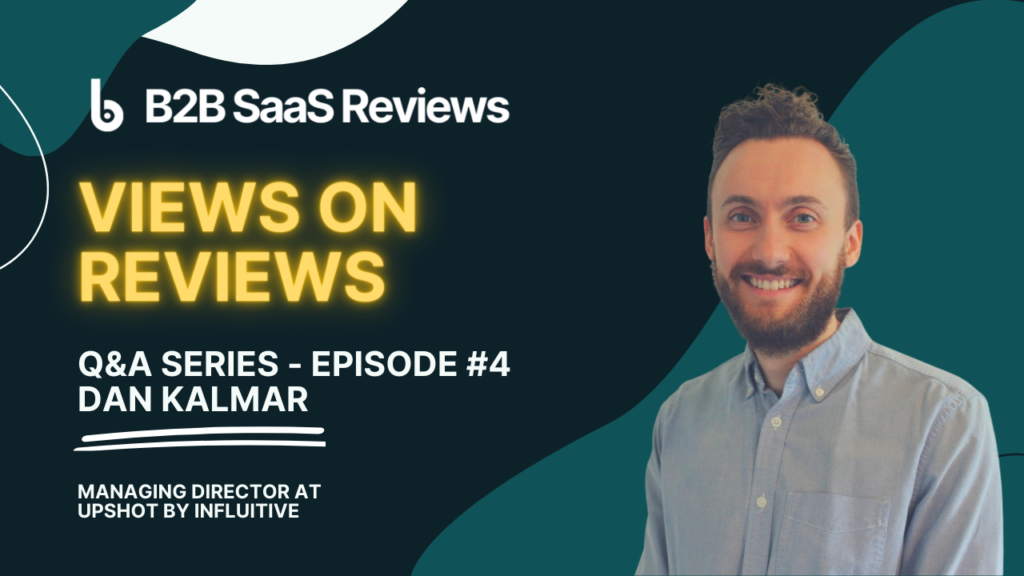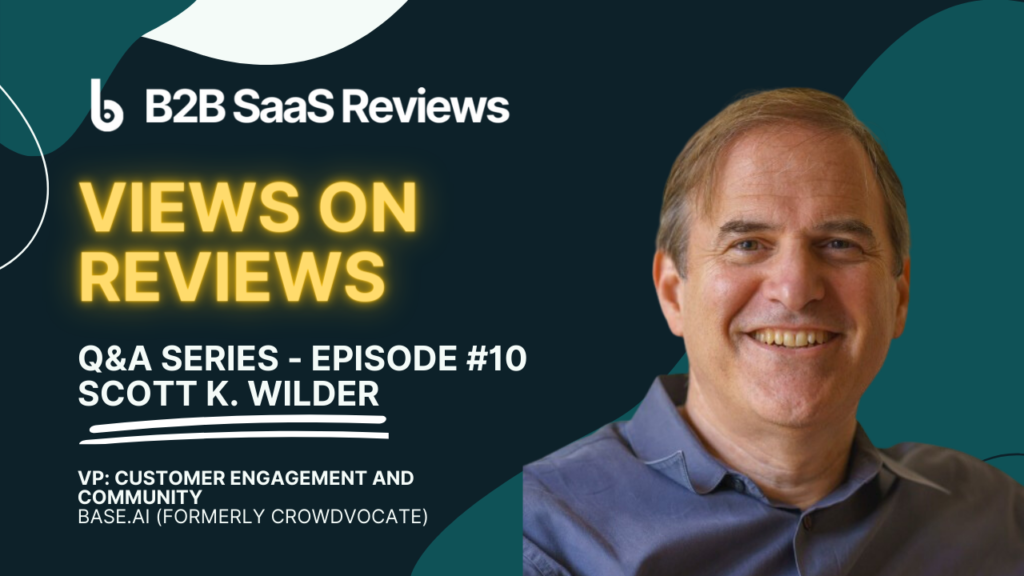Views on Reviews is a new series of interviews with B2B SaaS professionals who will provide a real-world perspective on what it’s like working on reviews. My fourth interview is with Dan Kalmar, Managing Director at Upshot By Influitive.

Dan Kalmar is the Managing Director at Upshot by Influitive, a customer story service provider.
He has produced customer stories for some of the largest B2B tech companies in the world. From household behemoths such as Cisco and HPE, to unicorn startups like Dropbox and Gong.
Part interviewer, part story crafter, Dan manages a team who make B2B marketing material you’ll actually want to read. He’s interviewed everyone from CEOs, doctors, and IT professionals, all in the name of bringing their stories to life—and to the masses.
With a background in agency-style work and in-house teams, he has experience producing content that translates highly technical subject matter into engaging, lead-generating narratives.
Let’s see Dan’s views on reviews.
1. You’ve been telling customer stories now for over a decade. How did you get into it? And what keeps you in it?
Answer: Not many people dream of being a customer marketer as a kid. On the content side, we often get into these roles because we were interested in business but also had a creative itch to scratch. I got into customer storytelling specifically because I loved helping people tell their stories. It started with a (now defunct) interview series I ran called The Blueprint where I interviewed founders of consumer electronics products about their journey of bringing products to life. My role with Upshot became a perfect combination of my interviewing, storytelling, and marketing skills.
2. For over 5 years, you’ve been telling customer stories through Upshot. What are some of the top customer advocacy lessons you’ve learned along the way?
Answer: The work we do at Upshot is all about authenticity—that’s been my biggest takeaway. Our prospects don’t inherently trust us. Why would they? Everyone is trying to market to them and get their money. And they’ve all been burned before. So what do we do? We—you know, the people they don’t trust—try to sell to them. But something happens when you tap into the voice of your customer and take a more advocacy-based approach to marketing. You get out of the way and let your customers do the selling for you. That’s one of the only ways to cut through the noise.
3. There are many ways to share the voice of the customer: online review sites, testimonials, references, and case studies. As a customer storyteller, what’s your take on where and how to best tell a B2B customer story?
Answer: Truly make it about the customer. So many marketers write “customer stories” that are all about them. It’s like they forgot it’s supposed to be a customer story. Make it more about the customer and their experience than any product or service. Humanize them. Build them up. Put the spotlight on the customer and their successes. More customers will agree to participate in these stories, and the stories will feel more authentic to the prospects reading them.
4. What is one mistake you see customer marketers make with customer stories?
Answer: I won’t keep harping on this make-it-about-the-customer point more than I already have, so I’ll go another route: they make them too short. We keep getting told that 800 words is the perfect content length. “No one has attention spans anymore!” “They can only maintain focus for 8 seconds!” That’s not even remotely true (if it were, we couldn’t drive cars). People watch one-hour Netflix shows. They listen to two-hour podcasts. People have attention spans, we just have a lower threshold for crap. When you look at the numbers, that 800-word length is often the worst length content can be. It’s too short to be quickly consumed, but not long enough to go truly in depth. If you’re a SaaS marketer, you’re not selling socks. You’re selling a complicated product and prospects want to truly see what it’s like. Give them an engaging, in-depth story, and you’ll see better engagement numbers.
5. You helped Valerio Battelli, Head of Global Advocacy and Operations at Cisco, tell the story of how Cisco “Increased Content Engagement 1,600% by Giving a Voice to Our Customers.” Valerio said, “we all want to learn from people who have faced the same issues as us, to hear about ways to be successful from someone who’s been in our shoes.” How did you / Upshot help Valerio apply this customer-centric approach at Cisco?
Answer: It’s funny, when we first started working with Cisco, I thought they wouldn’t “get it.” They’re a huge company, so I thought they’d want to do everything the old school way. There’s no way they’d want to take this unique approach to customer storytelling (stories written from the customers’ perspectives). I was totally wrong. So at Upshot, we helped because 100% of what we do is customer storytelling. We handle the heavy lifting of creating this content. But that only works when we have clients who are open to taking a new approach to customer storytelling. The authentic voice of the customer and advocacy, in general, are two hugely important initiatives for Cisco. More than anyone, they truly believe in letting the customer share their story—the good and the bad.
6. You’re the host of a new-ish podcast for Influitive, All About The Customer, talking with customer-obsessed people about best practices. You recently spoke with Jane Menyo, Head of Customer Marketing at Gong, and you asked her about getting user reviews on business software review sites. With Gong’s eye-popping 4,700+ reviews on G2, what did Jane share about Gong’s approach to review generation?
Answer: I loved Jane’s approach to fusing advocacy throughout the customer journey. She has this idea of high-calorie and low-calorie asks. Maybe you want to build up to getting a customer to speak at an event, but that’s a huge ask. Depending on where a customer is on their journey, you need to give them different options. Maybe they want something more in depth and will make a big splash like a speaking engagement. Other times, they want something easy. I think that’s been a big part of how they facilitate reviews: they ask people when they’re at their happiest (based on NPS surveys), and they give them different options depending on their appetite and bandwidth.
7. Why do you think reviews matter to a B2B SaaS vendor?
Answer: We instinctively know that prospects are wary of believing us. Reviews are (supposedly) that social proof we need. We want reviews (and word-of-mouth marketing in general) because it’s how we buy things. When we book a hotel, maybe we go on the hotel’s website to learn about the amenities, but we go on Tripadvisor to see what people actually experienced. Reviews (and other forms of social proof) are our way of saying, “Hey look, we’re not lying! Our solution really is great!”
8. What have you found works—and what doesn’t—in review generation (when asking for reviews)?
Answer: What doesn’t work: It’s important to understand that advocacy fatigue is a real thing. Constantly bombarding our customers with selfish asks (where there’s nothing in it for them) leads to burnout. What does work: Also, with reviews and references, a lot of times customer marketers wait too long. They think the customer needs to have used your product for X amount of time. The best time to ask your customer for a review is when they’re happiest. I don’t care if they’ve been with you for a week—at that point, maybe they can talk about how incredible the onboarding process was—or five years. The approach I’ve seen work best is to simply ask them when they’re happy—whenever that is on their journey.
9. On the Upshot site, you say, “Unlike traditional case studies, Upshot stories can hit anywhere from the top to bottom of the marketing funnel.” Can you elaborate on why Upshot stories can span the funnel?
Answer: When people think of customer stories, they mostly think of them as bottom-of-the-funnel assets—or maybe middle at best. With our approach of first-person storytelling, you can use these stories for anything. Maybe what you need is a customer to share a thought-leadership story about a common industry challenge, and they subtly bring you into the conversation. Maybe you need a more competitive analysis story, so you do a story showcasing how a customer made the decision on the right CRM to buy (spoiler alert: they chose yours). Marketers get into this fixed mindset with case studies because they’re doing traditional ones. When you take a unique, customer-focused approach, they can serve a lot of different parts of the funnel.
10. What’s next for Upshot?
Answer: Upshot isn’t everything to everyone. We do one thing (first-person customer stories) and we do it well. But after the work of interviewing the customer and producing this long-form story is done, most of the heavy lifting is complete. We want to explore providing more asset types that can be spun out of these stories while still staying true to our approach of authentic customer voices.
Key Takeaways:
- Get out of the way and let your customers do the selling for you. Help your customers tell their stories.
- Make your customer, not your solution, the hero of your customer success story.
- Don’t believe the BS on a supposed lack of attention in this day and age rendering long-form content ineffective. Don’t cut your customer story short to meet an 800-word content length standard. Your audience will still consume long-form content if it’s engaging.
- Ask for reviews when customers are at their happiest. Don’t wait for customers to become experts on your product before asking them for a review. Ask a satisfied customer while onboarding for a review. Their review can cover why they chose your solution, their onboarding, and their initial product impressions.
- Think about how you can tell customer stories that serve a purpose above the bottom of the funnel, such as having a customer share a thought-leadership story about a common industry challenge, and they subtly bring you into the conversation.
More Upshot by Influitive Stories on Reviews
Over the years, Upshot by Influitive has also told the review stories of QuickBase, Clinicient, LivePerson, Dundas Data Visualization, and my personal favourite, PowerDMS. Ray Lau, who launched and led a customer advocacy program for PowerDMS that drove $410,000 in less than a year, found that the most significant area where advocates helped had been online reviews. Click on the linked company names above to read their reviews story.
Do you have follow-up questions for Dan? Add and message him on LinkedIn. To learn more about Upshot by Influitive, visit their site.
If you’d like to share your experience generating, leveraging, or measuring B2B SaaS reviews, please email me: joe@b2bsaasreviews.com
Authors
-

I'm the Founder and Editor-In-Chief of B2B SaaS Reviews and the Director of Demand Generation at PartnerStack, the leading platform for partner management and affiliate marketing in B2B SaaS. My experience spans several notable B2B SaaS companies, including Influitive (Advocate Marketing), LevelJump (Sales Enablement, acquired by Salesforce), and Eloqua (Marketing Automation, acquired by Oracle). I hold a Bachelor of Commerce in Marketing Management from Toronto Metropolitan University and a Master of International Business from Queen's University, with academic exchanges at Copenhagen Business School and Bocconi University.
-





